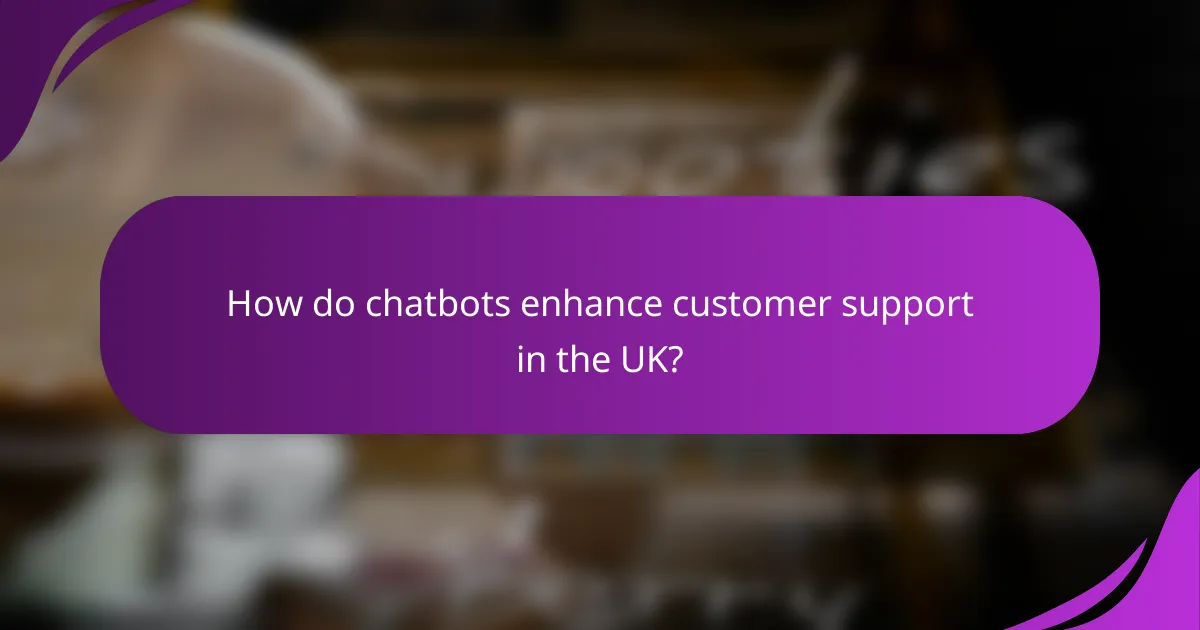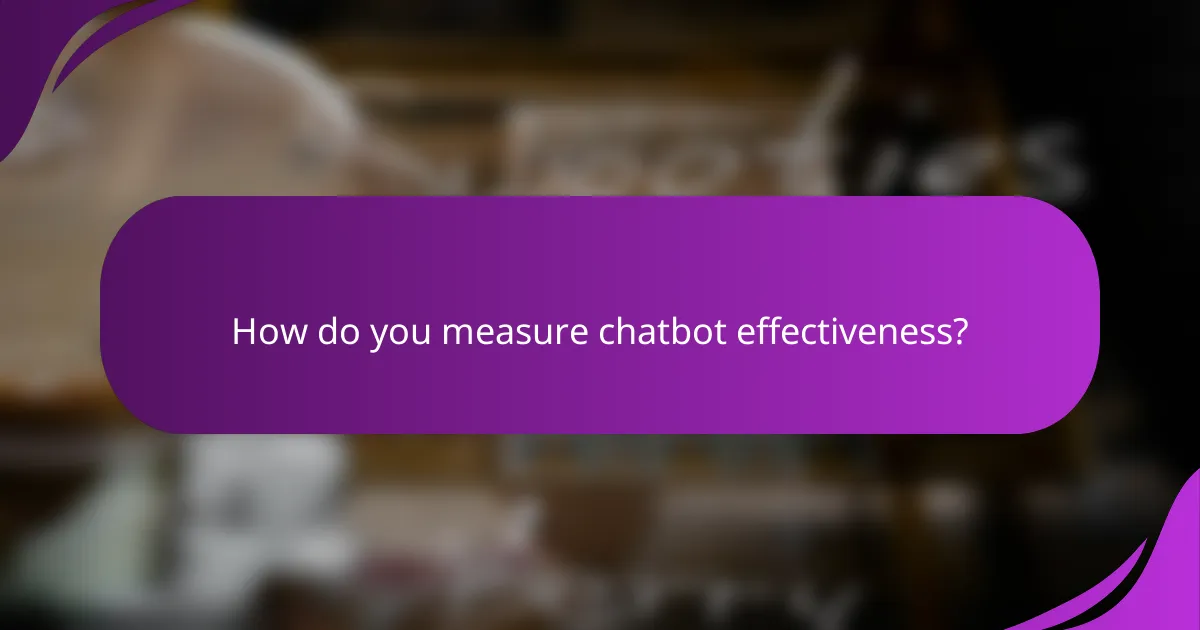Chatbots play a crucial role in transforming customer support by delivering instant assistance and enhancing operational efficiency. By automating routine inquiries and providing 24/7 availability, they ensure that customers receive timely help, significantly improving the overall customer experience across various industries.

How do chatbots enhance customer support in the UK?
Chatbots significantly enhance customer support in the UK by providing immediate assistance, improving efficiency, and elevating the overall customer experience. They enable businesses to respond to inquiries around the clock, ensuring that customers receive timely help without the need for human intervention.
24/7 availability
Chatbots offer round-the-clock availability, allowing customers to access support at any time, day or night. This constant accessibility is crucial for businesses operating in diverse time zones or those with customers who may need assistance outside of regular hours.
For example, a UK-based online retailer can address customer queries about orders or returns at any hour, reducing wait times and enhancing satisfaction. This availability can lead to increased customer loyalty and repeat business.
Instant query resolution
Chatbots can resolve queries instantly, often within seconds, which is a significant improvement over traditional support methods. They can handle common questions, such as order status or product information, without the need for human agents.
By automating these responses, businesses can free up their human staff to focus on more complex issues, improving overall efficiency. This instant resolution can lead to higher customer satisfaction, as users appreciate quick answers to their concerns.
Personalized interactions
Modern chatbots can deliver personalized interactions by utilizing customer data and previous interactions. They can greet returning customers by name and offer tailored recommendations based on past purchases or inquiries.
For instance, a chatbot for a UK travel agency might suggest holiday packages based on a user’s previous trips, enhancing the customer experience. Personalization not only makes interactions more engaging but also increases the likelihood of conversion and customer retention.

What are the benefits of using chatbots for efficiency?
Chatbots enhance efficiency by providing instant support, reducing wait times, and automating routine inquiries. This technology allows businesses to streamline operations and improve customer interactions without the need for constant human oversight.
Reduced response times
Chatbots can respond to customer inquiries in low tens of milliseconds, significantly faster than human agents. This immediate interaction minimizes customer frustration and enhances satisfaction, as users receive answers to their questions almost instantly.
By handling multiple inquiries simultaneously, chatbots eliminate the bottleneck of waiting for a human representative. This capability is particularly beneficial during peak hours when customer demand is high.
Cost savings for businesses
Implementing chatbots can lead to substantial cost savings for businesses, often reducing customer service costs by tens of percent. By automating routine tasks, companies can allocate human resources to more complex issues that require personal attention.
Additionally, chatbots operate 24/7 without the need for breaks or overtime pay, further decreasing operational expenses. This efficiency allows businesses to maintain high service levels while controlling costs.
Scalability of support
Chatbots provide scalable support, enabling businesses to handle increased customer inquiries without a proportional increase in staffing. This scalability is crucial for companies experiencing rapid growth or seasonal spikes in demand.
As customer bases expand, chatbots can be easily updated and integrated with existing systems, ensuring consistent service delivery. This adaptability makes them a valuable asset for businesses looking to enhance their customer support infrastructure.

Which industries benefit most from chatbots?
Chatbots are particularly advantageous in industries that require high-volume customer interactions, such as retail, healthcare, and financial services. They enhance efficiency, provide instant support, and improve overall customer experience by automating responses and streamlining communication.
Retail and e-commerce
In retail and e-commerce, chatbots assist customers by answering queries about products, processing orders, and handling returns. They can operate 24/7, ensuring that customer support is available at all times, which is crucial for online shoppers who may have questions outside of regular business hours.
For example, a chatbot can guide a customer through the purchasing process, recommend products based on preferences, and provide updates on order status. This not only enhances customer satisfaction but also reduces the workload on human staff, allowing them to focus on more complex issues.
Healthcare services
Healthcare services utilize chatbots to manage appointment scheduling, provide medication reminders, and answer common health-related questions. They can help patients navigate the healthcare system more efficiently, reducing wait times and improving access to information.
For instance, a chatbot can triage symptoms and direct patients to appropriate resources or specialists. This can be particularly useful in managing patient flow in clinics and hospitals, ensuring that healthcare providers can focus on critical cases while routine inquiries are handled automatically.
Financial services
In financial services, chatbots streamline customer interactions by providing account information, assisting with transactions, and answering questions about products like loans and credit cards. They enhance security by verifying user identity through conversational prompts, ensuring safe transactions.
For example, a banking chatbot can help users check their balances, transfer funds, or report lost cards, all while maintaining compliance with financial regulations. This not only improves customer experience but also reduces operational costs by minimizing the need for extensive customer service teams.

What features should you look for in a chatbot solution?
When selecting a chatbot solution, prioritize features that enhance user interaction and streamline support processes. Key aspects include natural language processing, integration capabilities, and analytics tools to measure performance and user satisfaction.
Natural language processing
Natural language processing (NLP) is crucial for enabling chatbots to understand and respond to user queries effectively. A robust NLP system allows the chatbot to interpret context, recognize intent, and manage variations in language, making interactions feel more natural.
Look for chatbots that support multiple languages and can handle slang or colloquialisms. This flexibility can significantly improve user experience, especially in diverse markets.
Integration capabilities
Integration capabilities determine how well a chatbot can work with existing systems, such as customer relationship management (CRM) software, e-commerce platforms, or help desk tools. A well-integrated chatbot can pull data from these systems to provide personalized responses and streamline workflows.
Ensure the chatbot can connect with APIs and third-party applications. This will allow for seamless data exchange and enhance the overall efficiency of customer support operations.
Analytics and reporting tools
Analytics and reporting tools are essential for tracking the performance of your chatbot. These tools provide insights into user interactions, common queries, and overall satisfaction, helping you identify areas for improvement.
Choose a chatbot that offers customizable reporting features, allowing you to focus on metrics that matter most to your business, such as response times and resolution rates. Regular analysis can guide updates and enhancements to the chatbot’s capabilities.

How do you measure chatbot effectiveness?
Chatbot effectiveness can be measured through various metrics that reflect its performance and impact on customer interactions. Key indicators include customer satisfaction scores, response accuracy rates, and engagement metrics, each providing insights into how well the chatbot meets user needs.
Customer satisfaction scores
Customer satisfaction scores (CSAT) gauge how satisfied users are with their interactions with the chatbot. This metric is typically collected through post-interaction surveys, where users rate their experience on a scale, often from 1 to 5 or 1 to 10.
To improve CSAT, focus on enhancing the chatbot’s ability to resolve issues quickly and accurately. Aim for a CSAT score above 80% to indicate strong performance, but continuously monitor feedback for areas of improvement.
Response accuracy rates
Response accuracy rates measure how correctly the chatbot answers user queries. This metric is crucial as it directly impacts user trust and satisfaction. A high accuracy rate, ideally above 90%, indicates that the chatbot is effectively understanding and addressing user needs.
To assess response accuracy, regularly review conversation logs and user feedback. Implementing machine learning algorithms can help improve accuracy over time by learning from past interactions.
Engagement metrics
Engagement metrics track how users interact with the chatbot, including the number of conversations, session duration, and user retention rates. High engagement suggests that users find the chatbot helpful and are willing to return for assistance.
Monitor these metrics to identify trends and areas for enhancement. For instance, if session durations are low, consider refining the chatbot’s conversational flow to keep users engaged longer. Aim for a balance between quick resolutions and meaningful interactions to optimize engagement.
